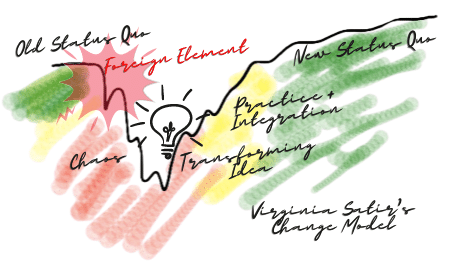Mike Cottmeyer writes about Feelings, Thoughts, and Actions.
When people have a strong response, Mike describes thoughts as the point of leverage to change behavior.
How we think can be influenced more directly… it is somehow less personal. We can learn about our environment and the people that are a part of our lives. We can gather more information about what motivates those around us and learn something about their intentions and circumstances. With new information, we can learn to think differently about what is happening to us…..By guiding thinking, we are able to broaden the perspective of our team and create the opportunity to coach behavior.
This lines up nicely with a model I use, Ingredients of an Interaction, from the work of Virginia Satir.
Intake: We take in data from the environment (filtered by our preferences, education, stress level…)
Meaning: We make an interpretation of the data (influenced by past experiences, education, stress level…)
Significance: We have a feeling, based not on the observed data, but on our interpretation of the data.
Response: We act out of our interpretation and feelings.
(Don Gray describes the Satir interaction model in more detail here.)
When Mike coaches about thoughts, he’s working on the level of Meaning, expanding the possible interpretations. When he talks about bringing in more information, he’s working on the level of Intake.
I find this is a powerful model for untangling communication that’s gone awry, and for understanding and shifting my own reactions.
***
On a related note, Mike talks about telling people their behavior is “unacceptable.”
Rather than start out by telling some one his behavior is unacceptable, I find it usually works better to get agreement that the behavior happened. That usually requires neutral language…rather than “you were pounding the table in our meeting today” I might say “In our meeting, I saw you raise your fist and bring it down on the table.” It’s too easy for people to get into a Yes-you-did/No-I-didn’t argument when there’s any hint of judgment in the description. If people don’t agree with the data, they aren’t likely to listen to anything else you say.
Once I’ve got agreement on the data, I talk about the impact of the behavior. “I was startled. I noticed that Jen and Josh both pulled back from the table, and didn’t say anything else for the rest of the meeting.” Depending on how the other person response, I might go further. “When you hit the table, its hard for me to continue participating in the meeting. What I see is that when you bring your fist down on the table, it gets in the way of people listening to your ideas” (or something like that).
I’d rather let the person conclude that the behavior is ineffective and counter-productive and make a different choice. I find that works better with adults than having me say “That behavior is unacceptable”….especially since it may have been accepted in the person’s family, or some previous context (where they learned it, and where it might have worked–on some level).
There are times when I do say “that behavior is unacceptable here,” but I usually don’t need to do that with reasonably well-adjusted adults.









0 Comments